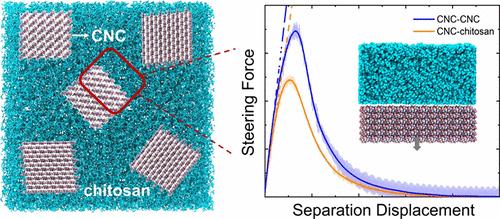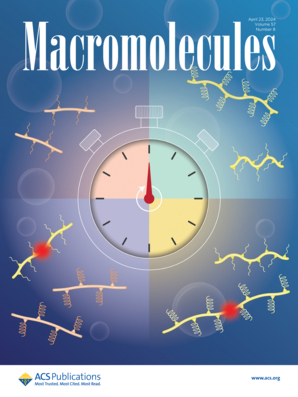Interfacial Mechanical Behavior of Cellulose Nanocrystals and Chitosan
IF 5.2
1区 化学
Q1 POLYMER SCIENCE
引用次数: 0
Abstract
Natural nanocomposites based on cellulose and chitosan have attracted much attention as alternatives to petroleum-based plastics. However, much less is understood about the interfacial properties between cellulose nanocrystals (CNCs) and chitosan that are essential for tuning the thermomechanical properties of CNC–chitosan nanocomposites. Here, we systematically investigate the interfacial behavior of CNC–CNC and CNC–chitosan systems by using atomistic molecular dynamics. The introduction of an interface has a significant influence on the structure and molecular mobility of chitosan near the interface, while it has a negligible effect on the CNC–CNC system due to its layered structure in the traverse directions perpendicular to the chain direction. The tension separation simulations demonstrate that in comparison with the CNC–CNC interface, the interfacial adhesive strength and stiffness of the CNC–chitosan interface decease but still maintain relatively high values. The hydrophilic (110) and (010) surfaces of CNC exhibit a better dispersion factor (∼0.7) in the chitosan matrix than the hydrophobic (100) surface. Moreover, the shear responses indicate that the underlayer CNC exhibits a stick–slip behavior at the CNC–CNC interface, while a smooth sliding is observed at the CNC–chitosan interface, leading to a smaller interfacial shear strength. With the insertion of chitosan as an intermediate layer at the CNC–CNC interface, the interfacial shear modulus progressively decreases with the increasing chitosan content for a chitosan thickness smaller than 9 nm, and it has a linear relationship with the reciprocal of molecular mobility of the chitosan layer. Our study provides fundamental insights into the influence of chitosan on the interfacial mechanical properties of CNCs and sheds light on the design of high-performance CNC–chitosan nanocomposites.

纤维素纳米晶与壳聚糖的界面力学行为
基于纤维素和壳聚糖的天然纳米复合材料作为石油基塑料的替代品受到了广泛的关注。然而,人们对纤维素纳米晶体(cnc)和壳聚糖之间的界面特性知之甚少,而这些特性对于调节cnc -壳聚糖纳米复合材料的热机械性能至关重要。本文采用原子分子动力学方法系统地研究了CNC-CNC和cnc -壳聚糖体系的界面行为。界面的引入对界面附近壳聚糖的结构和分子迁移率有显著影响,而对CNC-CNC系统的影响可以忽略不计,因为它在垂直于链方向的横方向上呈层状结构。拉伸分离模拟结果表明,与CNC-CNC界面相比,cnc -壳聚糖界面的界面粘接强度和刚度有所下降,但仍保持较高的数值。CNC的亲水性(110)和(010)表面在壳聚糖基体中的分散系数(~ 0.7)优于疏水性(100)表面。此外,剪切响应表明,底层CNC在CNC - CNC界面上表现为粘滑行为,而CNC -壳聚糖界面上则表现为光滑滑动,导致界面剪切强度较小。当壳聚糖作为中间层插入CNC-CNC界面时,当壳聚糖厚度小于9 nm时,界面剪切模量随壳聚糖含量的增加而逐渐减小,且与壳聚糖层分子迁移率的倒数呈线性关系。本研究为研究壳聚糖对纳米复合材料界面力学性能的影响提供了基础,并为高性能纳米复合材料的设计提供了思路。
本文章由计算机程序翻译,如有差异,请以英文原文为准。
求助全文
约1分钟内获得全文
求助全文
来源期刊

Macromolecules
工程技术-高分子科学
CiteScore
9.30
自引率
16.40%
发文量
942
审稿时长
2 months
期刊介绍:
Macromolecules publishes original, fundamental, and impactful research on all aspects of polymer science. Topics of interest include synthesis (e.g., controlled polymerizations, polymerization catalysis, post polymerization modification, new monomer structures and polymer architectures, and polymerization mechanisms/kinetics analysis); phase behavior, thermodynamics, dynamic, and ordering/disordering phenomena (e.g., self-assembly, gelation, crystallization, solution/melt/solid-state characteristics); structure and properties (e.g., mechanical and rheological properties, surface/interfacial characteristics, electronic and transport properties); new state of the art characterization (e.g., spectroscopy, scattering, microscopy, rheology), simulation (e.g., Monte Carlo, molecular dynamics, multi-scale/coarse-grained modeling), and theoretical methods. Renewable/sustainable polymers, polymer networks, responsive polymers, electro-, magneto- and opto-active macromolecules, inorganic polymers, charge-transporting polymers (ion-containing, semiconducting, and conducting), nanostructured polymers, and polymer composites are also of interest. Typical papers published in Macromolecules showcase important and innovative concepts, experimental methods/observations, and theoretical/computational approaches that demonstrate a fundamental advance in the understanding of polymers.
 求助内容:
求助内容: 应助结果提醒方式:
应助结果提醒方式:


